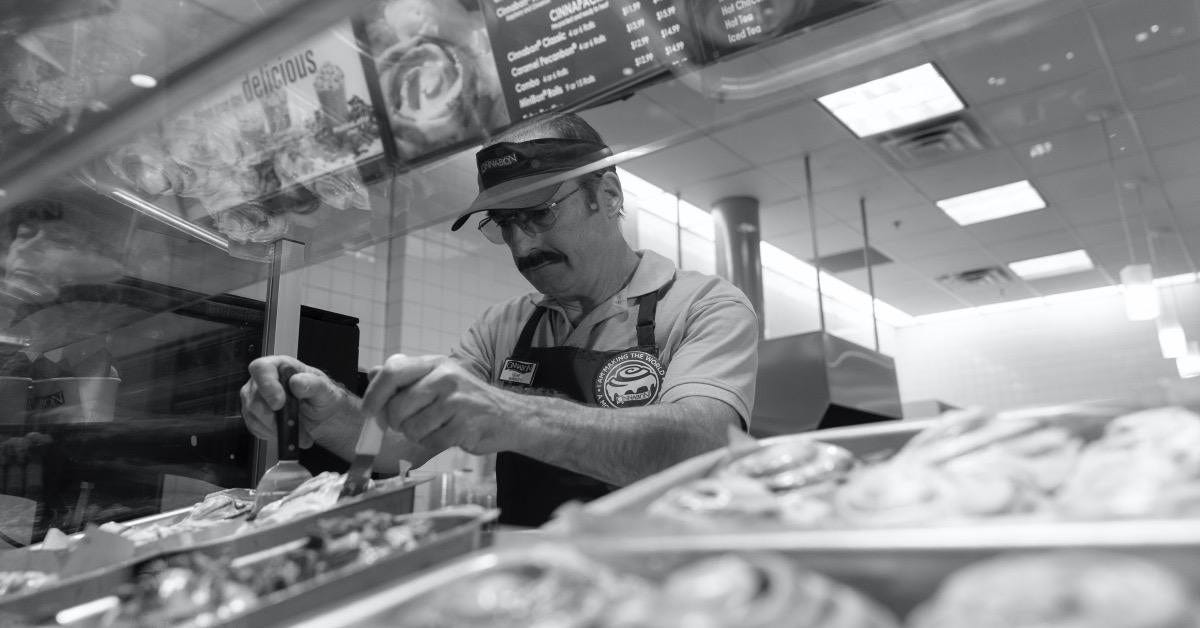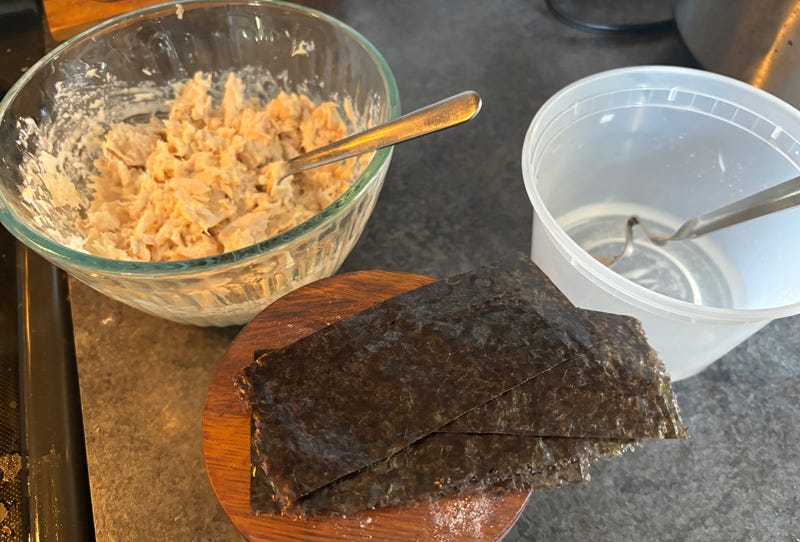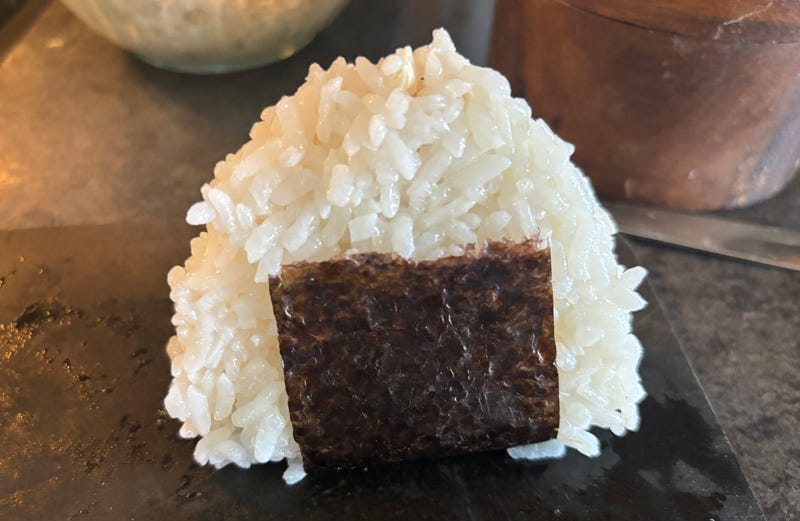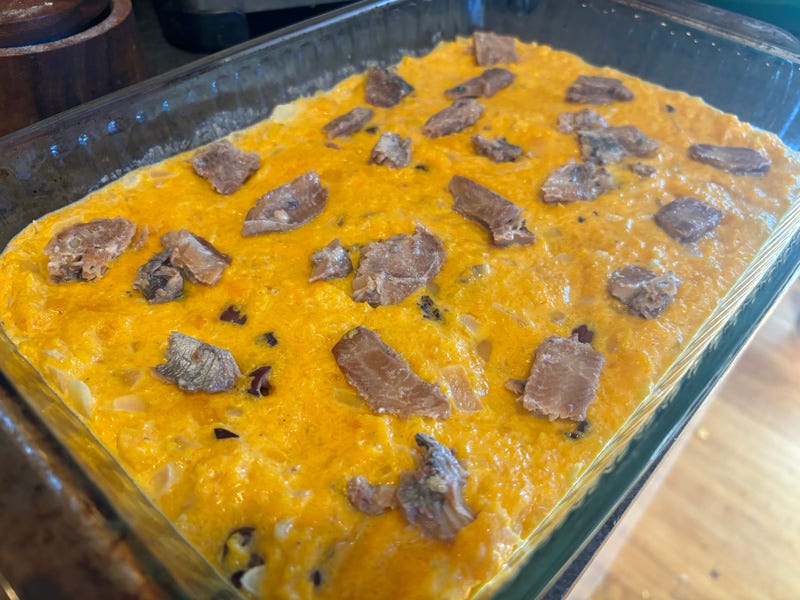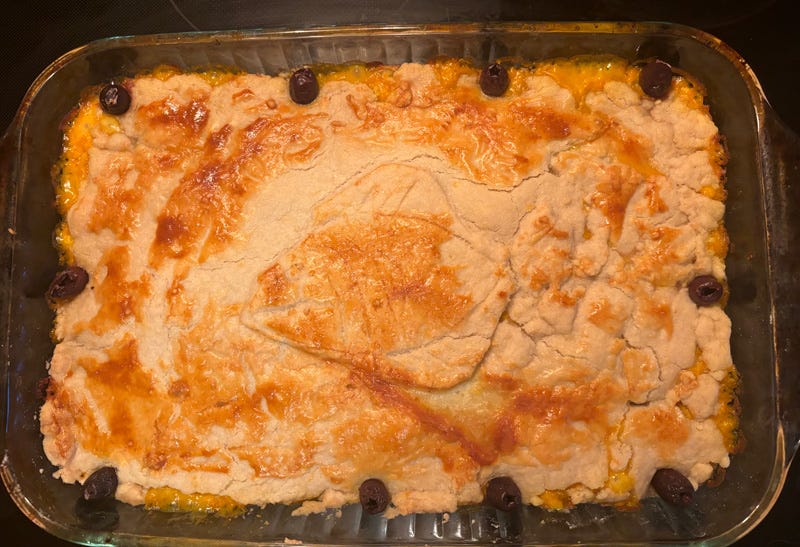THE COOKBOOK TEST #0028: STUDIO GHIBLI COOKBOOK
INSTALLMENT #0028 (FREE) CRYING ALL THE WAY TO THE BANK / TIED IN / TUNA ONIGIRI / SOME KIND OF DUBIOUS FISH PIE THING
Dear Readers,
I've seen three Studio Ghibli films: Spirited Away, My Neighbor Totoro, and Grave of the Fireflies. I can't precisely remember when I cried during Spirited Away, but it definitely happened. I cried near the end of My Neighbor Totoro when everyone was desperately looking for the lost little girl (who DID NOT die and was fine, thank goodness). And I definitely cried at the end of Grave of the Fireflies, plus one or two other times (memory is fuzzy on that point, it's been awhile.)
I don't typically cry at movies. But there is something so legitimately beautiful / heart rending / poetic / painfully human about Studio Ghibli's animated features that their work really deserves to be honored among the planet's best pieces of art, animated or otherwise. It's a testament to what human artists working with intelligence and sensitivity can accomplish when supported by a team that is focused on creating something great and enduring.
The STUDIO GHIBLI COOKBOOK: UNOFFICIAL RECIPES INSPIRED BY SPIRITED AWAY, PONYO, AND MORE! is not particularly great nor do I suspect it'll be very enduring. Each recipe follows precisely the same template: brief introduction to a Studio Ghibli film, connection with a meal or piece of food, transition into recipe for said food. There's not a lot of “there” there - nothing in terms of cinematic analysis, nor any culinary soul searching about the right recipe or recipe variant to match the tone or story of any given film.
Studio Ghibli is known for its depictions of food, though - they're famously appetizing, and the Studio Ghibli Cookbook does a reasonably good job of picking dishes that are right in the mix as opposed to tangentially or not-at-all connected to the story in question (see: The Columbo Cookbook.)
One thing I felt pretty sure about when I picked up the Studio Ghibli Cookbook: It probably wouldn't include a recipe from Grave of the Fireflies, a film that famously tells the story of two orphaned siblings, aged 14 and 4, who SLOWLY STARVE TO DEATH AFTER THEIR CITY IS BOMBED BY B-29 SUPERFORTRESSES, AN EVENT THAT ALSO KILLS THEIR MOM. But: no. If you want to remember when those lovable doomed kids ate foraged river clams and the very last of their white rice, that recipe is made available to you here. The Studio Ghibli Cookbook is nothing if not completist. [1]
at your service,
James
STUDIO GHIBLI COOKBOOK: UNOFFICIAL RECIPES INSPIRED BY SPIRITED AWAY, PONYO, AND MORE!
RECIPES BY MINH-TRI VO AND BACKGROUND TEXT BY CLAIRE-FRANCE THÉVENON
INSIGHT EDITIONS | 2022 (ORIGINALLY PUBLISHED IN FRANCE IN 2020) | $30
When reviewing tie-in gimmick books like this one, it seems wise to assess how much the book actually brings you into the world it claims to gatekeep. The Columbo Cookbook, as I'll keep mentioning: not at all. The Minecraft Cookbook, kind of, at least a fair bit of the stuff you make is kind of block-shaped. The Studio Ghibli Cookbook actually gets pretty high marks - even through the contextual introductions are bare bones, most if not all of the foods are explicitly depicted in the films, and many actually play some sort of pivotal role (the botched beef stroganoff in My Neighbors the Yamadas, the bento carried on a picnic in My Neighbor Totoro, the tasty clams and rice in Grave of the Fireflies BEFORE THE KIDS FREAKIN' STARVED TO DEATH, and so forth.)
I was thinking that it's a little hard for me to relate to this because there isn't a fictional universe that I long to slip into and experience by way of food, but then I thought: "Damn if I didn't love Better Call Saul as much or more than pretty much any other piece of media I've ever experienced."
And then I remembered: The day the final episode of Better Call Saul aired, I drove out to the nearest Cinnabon store so that I could chow down on a Cinnabon with icing while I said goodbye to what might be the best TV show I've ever watched. So I guess I sort of do get it after all.
TUNA ONIGIRI
The Tuna Onigiri recipe in the Studio Ghibli Cookbook is one of my least favorite kinds of recipes - it is a method posing as a recipe. If you followed it as written, to the letter, you would end up with a shapeless, disastrous free form salad of rice and tuna, with far too much (unseasoned) tuna and rice that is way too wet to handle.
I came into the recipe knowing enough about sushi that I was able to dodge various pain points, but ultimately my onigiri were still a little slumpy and unattractive. That's probably more a factor of my own talent (or lack thereof) than anything that can be rendered in words, but it's a little note of caution that you should take every step of this method fairly carefully if you want to get a good result.
Here's what I changed about the original recipe: I added a detail about weighing out your seasoned rice so as to get four equally sized onigiri. I added seasoning to the tuna, because it tastes notably better. I changed the rice type from jasmine (?!) to short-grain sushi rice. I added a caution about using too much dressing, because the recipe creates more than you'll need. And I added a note about using too much tuna, because the standard 5 oz. can is enough fish to make at least 12 of these onigiri, if not 16, and this recipe only makes four.
The good news: other than almost everything about this recipe being broken or incomplete, it's pretty tasty - warm seasoned rice with mayo-seasoned tuna is actually quite delicious. Chihiro (the star of Spirited Away, who is prevented from turning into a pig by an enchanted onigiri given to her by a dragon in disguise) would certainly appreciate that.
TUNA ONIGIRI
Makes 4
1 cup uncooked short-grain sushi rice
4 Tbsp distilled white vinegar
1 tsp salt
2 tsp sugar
One 5-oz. can of tuna
1 Tbsp or more of mayonnaise to taste
Salt and pepper
4 strips of toasted nori
Get your rice going in your rice cooker. Meanwhile: Mix your vinegar, salt, and sugar into a dressing. Mix your tuna with mayonnaise and some salt and pepper to season. Cut your nori into four 3x1" strips.
When your rice is cooked and still hot, move it into a tared bowl on a kitchen scale. Stir in some of your dressing, fanning as you go - you will probably use less than half. You want your rice to be moist and seasoned, but not have any dressing pooling at the bottom of the bowl. Add small amounts, stir thoroughly, and fan.
Note the weight of your seasoned rice. Remove 1/4 of the weight, and split your rice into two equal piles. Flatten one pile into a disc, and add a heaping tablespoon-sized lump of seasoned tuna in the center of your disc of rice. Cover with the other half of the rice, and then shape into a thick, rounded triangle. Add a strip of nori to the base of the triangle, riding partially up the front and back of the onigiri.
Repeat three more times. You'll have a lot of extra tuna (which can make tuna salad, or what-have-you) and a fair amount of dressing (discard.)
HERRING AND PUMPKIN PIE? IN THIS ECONOMY?!
Whenever I see something on a menu or in a cookbook that seems truly deranged, I always do my best to interact with it. Usually these things are the result of some sort of logical leap - spurred by greed, or imagination, or chemical-induced confusion - and they can be educational, funny, or even - rarely - shockingly delicious.
That's the context for why I decided to execute the herring and pumpkin pie in Studio Ghibli Cookbook, a callback to that memorable moment when Kiki of Kiki's Delivery Service delivered a herring and pumpkin pie to someone who complains: "I hate Grandma's stupid pies."
Here's the culinary premise of the pie: you steam an entire butternut squash (cut down into pieces), mash it up, add garlic and onions and heavy cream and chopped olives and butter, pack the mush into a glass baking pan, top it with slices of smoked herring filets, and then cover it with a decorative crust. Bake for 40 minutes, and voila!
Or: Voila? I was concerned before making this dish that it wouldn't really make any sense when it was finally executed, and that concern was pretty sensible. The most flattering thing you can say about this squash-meets-garlic-meets-fish situation is that it kind of tastes like a solid version of clam chowder, what with the creaminess, the crust (sort of like oyster crackers or bread or whatever), and the lingering herring aftertaste.
But I would far rather make clam chowder next time because it would be a) a lot easier and b) a lot tastier. I'm not sure who the target market for fishy-tasting smoked herring filets is, but it's not me, and I would prefer to not experience them in pie format ever again.
In conclusion: I, too, hate Grandma's stupid pies, which is maybe not the lesson that the cookbook was trying to teach? It isn't clear from the book's introductory text for this recipe, which kind of presents the whole thing in a neutral light without making any claims about the pie being delicious or magical or even vaguely worth the effort.
I'm not including the recipe here because it was an enormous waste of time and ingredients, but if you feel strongly that you want to try it, drop me a message or comment and I'll send you the details along with a sternly worded "I warned you not to make this" sort of disclaimer message.
THE VERDICT ON THE STUDIO GHIBLI COOKBOOK
(BUY IT / BORROW IT / ***SKIP IT*** / SCRAP IT)
While a far cry from some of the unusable, AI-generated hit-and-run fan service cookbooks out there - most of Studio Ghibli Cookbook's recipes seem to at least function on a basic level - there's nothing here from a cinematic insight perspective or culinary achievement perspective to demand purchasing. Based on the two recipes I attempted, I wouldn't trust this book in the hands of a culinary novice or even apprentice - there are some reasonably big gaps that beginning cooks are likely to fall through.
[1] AUTHOR'S NOTE: The Wikipedia page for Grave of the Fireflies says: "Despite the public's emotional reaction, [director Isao] Takahata expressed that the purpose of the film was not to be a tragedy or make people cry." COME ON DUDE. We watch two adorable young kids pluckily struggle through a wartime disaster and then stone-cold starve to death! It's the cinematic equivalent of hitting every individual moviegoer in the audience in the knees with a sledgehammer and then laughing at them, and then saying: "Oh, what, you're upset? You're going to CRY?! I was just trying to shatter your kneecaps and then laugh at you, that's not a reason to CRY." I mean, it's a good film, but come on, you ABSOLUTELY knew this thing was going to make people cry.



